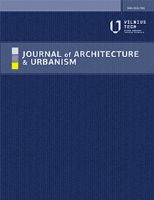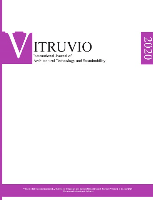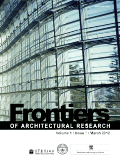
Journal of Architecture and Urbanism
Scope & Guideline
Innovating Architecture for Sustainable Cities
Introduction
Aims and Scopes
- Architectural Theory and Critique:
The journal emphasizes theoretical frameworks in architecture, exploring aesthetic, cultural, and functional dimensions of built environments through critical discourse. - Urban Design and Planning:
It investigates the principles and practices of urban design, focusing on how urban spaces can be shaped to enhance social interaction, sustainability, and resilience. - Historical Analysis and Preservation:
The journal examines historical architecture and urban forms, emphasizing the importance of preservation and adaptation of heritage in contemporary contexts. - Sociocultural Impacts of Architecture:
A core area of focus is the social production and consumption of space, analyzing how architecture and urbanism affect community dynamics and individual experiences. - Environmental Sustainability:
The journal addresses sustainable practices in architecture and urban planning, exploring eco-friendly design strategies and the role of green spaces in urban settings. - Innovative Research Methodologies:
It promotes the use of innovative research methods, including digital tools and diachronic analysis, to study urban morphologies and spatial configurations.
Trending and Emerging
- Social Change through Architecture:
A growing trend is the exploration of architecture and urban design as catalysts for social change, emphasizing how built environments can address social inequalities and foster community engagement. - Sustainable Urban Practices:
There is an increasing focus on sustainability, including studies on green spaces, eco-integrative design, and energy-efficient rehabilitation, reflecting a broader societal push towards environmental stewardship. - Digital Tools and Technologies in Design:
The use of digital rendering and innovative technologies is becoming more prevalent, with research examining their impact on spatial identity and urban design processes. - Health and Well-Being in Urban Spaces:
Emerging themes include the relationship between urban design and public health, particularly how architectural features can promote well-being and physical activity in urban settings. - Cultural Narratives in Architecture:
An increase in research that integrates cultural narratives and community identity into architectural practices, reflecting a desire for inclusivity and representation in urban environments.
Declining or Waning
- Traditional Architectural Styles:
Over time, there has been a noticeable shift away from studies focused solely on traditional architectural styles, as contemporary and innovative design approaches gain more prominence in the journal's publications. - Regionalism in Urban Design:
Themes related to regionalism and localized design practices have become less frequent, possibly due to a broader interest in global urbanization trends and the challenges of modern cities. - Static Urban Models:
Research concentrating on static models of urban design has waned, with a shift towards more dynamic and adaptive frameworks that account for evolving urban contexts. - Historical Narratives without Contemporary Relevance:
Papers that solely recount historical narratives without connecting them to contemporary issues or future applications have seen a decline, as the journal emphasizes relevance to current urban challenges.
Similar Journals

Prostor
Advancing Architectural Dialogue for a Sustainable FutureProstor is an esteemed scholarly journal published by the University of Zagreb, Faculty of Architecture, dedicated to advancing knowledge in the fields of architecture, urban planning, and spatial studies. Since transitioning to an Open Access model in 2006, Prostor has made significant strides in providing unrestricted access to its contents, fostering a vibrant community of researchers, practitioners, and students interested in contemporary issues surrounding the built environment and social space. The journal's commitment to quality is reflected in its impressive rank within Scopus, particularly in the Arts and Humanities category (64th percentile) and within Engineering (Architecture) at the 49th percentile. Covering a broad array of interdisciplinary topics, Prostor serves as a vital platform for disseminating innovative research and fostering dialogue among professionals while engaging with practical and theoretical explorations of spatial design. With coverage spanning over two decades, Prostor remains a crucial resource for anyone seeking to navigate the complexities of architecture and urban studies.

Festival dell Architettura Magazine
Illuminating Contemporary Architectural ThoughtFestival dell Architettura Magazine, published by FESTIVAL ARCHITETTURA EDIZIONI, is a distinctive Open Access journal dedicated to the realms of architecture, urban studies, and the visual and performing arts. Established with a vision to foster interdisciplinary dialogue, the journal has been a part of the academic landscape since 2013 and has converged its insightful contributions from 2018 to 2023. Despite being ranked in the lower quartiles in its respective categories—Q4 in Architecture and Urban Studies, and Q3 in Visual Arts and Performing Arts—this publication remains vital for emerging researchers and seasoned professionals alike, as it provides a platform for innovative ideas and practices from Italy and beyond. It serves as a key resource for those who wish to engage with contemporary architectural thought and cultural expressions, facilitating open access to research that highlights the intersections of space, society, and art.

ACE-Architecture City and Environment
Transforming Ideas into Sustainable Urban SolutionsACE-Architecture City and Environment, published by Universitat Politècnica de Catalunya in Spain, serves as an essential repository for innovative research and insights that intersect the fields of architecture, urban studies, and environmental planning. Since its establishment as an Open Access journal in 2006, it has facilitated widespread accessibility to scholarly work, fostering a collaborative and inclusive academic community. The journal has consistently maintained a prominent standing within its field, reflected in its 2023 Quartile rankings—, Q3 in Geography, Planning and Development, and Q2 in Urban Studies. With a publication horizon extending from 2011 to 2024 and an impressive Scopus ranking among peers, it offers a comprehensive platform for researchers to disseminate their findings and engage with contemporary challenges in urban environments. ACE is pivotal for professionals and students alike, striving to shape the future of sustainable architecture and urban planning through rigorous scholarship.

VITRUVIO-International Journal of Architectural Technology and Sustainability
Advancing sustainable design for a better tomorrow.Welcome to the VITRUVIO-International Journal of Architectural Technology and Sustainability, a leading open-access journal published by UNIV POLITECNICA VALENCIA, EDITORIAL UPV since 2015 and based in Spain. With its ISSN 2444-9091, this journal is dedicated to advancing the field of architectural technology and sustainability, providing a vital platform for researchers, professionals, and students alike. The journal has made significant strides in the academic landscape, achieving a Q3 ranking in Architecture and a Q4 ranking in Building and Construction for 2023. It features a diverse range of scholarly articles that explore innovative practices, cutting-edge research, and sustainable solutions in architecture. With a Scopus ranking placing it at #70/189 in Architecture and #161/223 in Building and Construction, it is positioned within the 63rd percentile and 28th percentile respectively, demonstrating its increasing impact in these vital fields. We invite you to engage with our content and contribute to the ongoing discourse around sustainability in architectural practice.

Materia Arquitectura
Connecting minds to redefine the future of design.Materia Arquitectura, published by the Universidad San Sebastián, Facultad de Arquitectura y Arte in Santiago, is a leading open-access journal dedicated to the dynamic field of architecture. With its ISSN 0718-7033, this journal has established itself as a vital platform for disseminating cutting-edge research, innovative design practices, and critical discourse surrounding architectural theory and education since its transition to open access in 2017. The journal's commitment to fostering academic collaboration and knowledge sharing is reflected in its inclusive approach, welcoming contributions from researchers, practitioners, and students alike. By providing free and worldwide access to its content, Materia Arquitectura significantly enhances the visibility and impact of architectural scholarship, making it an essential resource for anyone invested in the future of architecture and design.

A + U-ARCHITECTURE AND URBANISM
Innovating Urban Narratives through ArchitectureA + U - ARCHITECTURE AND URBANISM, published by A & U PUBL CO LTD, is a prominent Japanese journal that focuses on the interdisciplinary nexus of architecture, urban studies, and the visual arts. With an ISSN of 0389-9160, this publication aims to provide a platform for innovative research and discourse in the challenging and ever-evolving landscapes of architecture and urbanism. Despite being placed in Q4 of various categories according to Scopus ranks, this journal holds significance in fostering global dialogues on urban transformations and design strategies through its diverse range of articles. The journal emphasizes not only the aesthetic dimensions of architecture but also the social and cultural implications of urban development, thereby appealing to a broad audience of researchers, professionals, and students dedicated to these fields. With a commitment to enriching the academic community, A + U serves as a vital resource for those seeking to explore and contribute to the future of urban spaces and architectural practices.

Architektura & Urbanizmus
Empowering Voices in Architecture and Urban ConservationArchitektura & Urbanizmus is a distinguished scholarly journal published by the Institute of History at the Slovak Academy of Sciences, with a specific focus on the fields of architecture, conservation, and urban studies. Since its transition to Open Access in 2021, the journal aims to broaden the accessibility of vital research findings to a global audience, fostering knowledge-sharing and collaboration among scholars, practitioners, and students alike. The journal has consistently contributed to the academic discourse since its inception and now spans converged years from 2007 to 2023, adapting to the evolving landscape of its disciplines. With its categorization in Q3 for both Architecture and Conservation, and Q4 in Urban Studies for 2023, it stands as a credible platform for disseminating innovative research and practical insights. The journal's current Scopus rankings reflect its growing influence in the field, offering a significant opportunity for researchers to contribute original work that addresses contemporary challenges in architecture and urban development. Situated in the heart of Bratislava, Slovakia, at Klemensova 19, Architektura & Urbanizmus invites contributions that enrich the architectural heritage and environmental integrity of urban spaces.

Dearq
Advancing Knowledge in Architecture and Urban StudiesDearq, an esteemed academic journal published by UNIV ANDES, is recognized as a vital source of knowledge in the fields of Architecture, Geography, Planning, and Urban Studies. As an Open Access journal since its inception in 2007, it provides researchers, professionals, and students with a platform to disseminate high-quality research that fosters innovation and progress in these dynamic disciplines. With an impressive track record of converging research from 2019 to 2024, Dearq currently holds a Q2 ranking in Architecture and Q3 rankings in both Geography, Planning, and Development, as well as Urban Studies for 2023. This editorial momentum reflects its commitment to advancing scholarly dialogue and critical inquiry. Located in Colombia and fostering a global perspective, Dearq is dedicated to enriching the academic landscape, making it an indispensable resource for anyone seeking to explore and understand complex socio-environmental issues.

Frontiers of Architectural Research
Bridging Disciplines to Redefine Urban SpacesFrontiers of Architectural Research, published by KEAI PUBLISHING LTD, stands at the forefront of interdisciplinary scholarship, addressing contemporary challenges in the fields of architecture, urban studies, building and construction, and archaeology. Since its establishment in 2012, this open-access journal has rapidly gained recognition, achieving prestigious rankings in the 2023 category quartiles, including Q1 placements in both Architecture and Archaeology. With an impressive Scopus rank of #5 out of 354 in Archaeology and #10 out of 189 in Engineering - Architecture, it demonstrates its significant influence and contribution to advancing architectural research. Frontiers of Architectural Research embraces a broad scope that fosters innovative discourse and practical solutions, catering to a diverse audience of researchers, professionals, and students keen on exploring the intersection of culture, environment, and technology. By ensuring immediate access to research findings, the journal not only enhances the visibility of scholarly work but also encourages collaborative dialogues that shape the future of architectural practice.

Teka Komisji Urbanistyki i Architektury
Navigating the Challenges of Urban Development Together.Teka Komisji Urbanistyki i Architektury is an esteemed journal published by the Polska Akademia Nauk (Polish Academy of Sciences), dedicated to advancing the fields of urban planning and architecture. With its ISSN 0079-3450 and E-ISSN 2450-0038, this scholarly publication plays a pivotal role in disseminating innovative research, critical analysis, and theoretical advancements related to urban development and architectural design. Although not currently available as an open-access journal, it remains essential for researchers, professionals, and students eager to stay informed about contemporary challenges and solutions in the built environment. The journal emphasizes high-quality, peer-reviewed articles that stimulate scholarly debate and foster interdisciplinary collaboration among contributors from diverse academic backgrounds. Consequently, it has emerged as a vital resource for developing urban planning policies and architectural practices, both in Poland and globally.